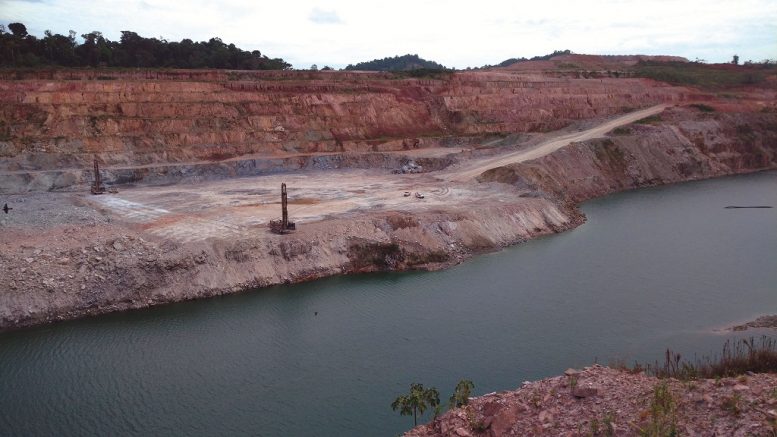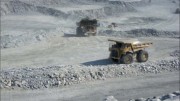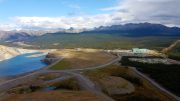PARAMARIBO, SURINAME — Only a few years ago during the depths of the mining industry downturn, Iamgold (TSX: IMG; NYSE: IAG) had on its hands with its Rosebel open-pit gold mine in Suriname an aging, high-cost operation that faced closure in 2018, as costs were projected to rise well above the prevailing gold price. But the intermediate gold producer didn’t give up on the ailing asset and instead embarked on a major operational turnaround that squeezed efficiencies out of virtually every aspect of the business.
This resulted in improved productivity per worker and it dropped all-in sustaining costs (AISCs) at Rosebel from break-even levels or worse to well below spot prices. It also brought millions of gold ounces into reserves and resources.
The Rosebel mine has been transformed into a profitable, cornerstone asset for Iamgold, which also has operating gold mines and major development assets in Burkina Faso, Mali, Quebec and Ontario.
Rosebel’s mine life now extends to 2028 and beyond, based on resources and reserves recalculated in mid-2017 to total 11.8 million oz. gold within the Rosebel mine property — joining the rarified group of gold deposits worldwide that surpass the 10 million oz. mark.
And this comes on top of the 4.8 million oz. gold that has already been mined at Rosebel from eight pits exploiting gold deposits occurring along two large trends that intersect in a large “V” pointing east.
The northern mineralized trend has a 12 km strike length and hosts the Pay Caro, East Pay Caro, Koolhoven and J-Zone deposits, while the southern trend has a 15 km strike length and hosts the Mayo, Royal Hill and Roma deposits.

Dumping ore at Iamgold’s Rosebel gold mine in Suriname. Photo by John Cumming.

Conveying ore into the mill at Iamgold’s Rosebel gold mine in Suriname. Photo by John Cumming.

Tanks at Iamgold’s Rosebel gold mine and mill in Suriname. Photo by John Cumming.

Inside the mill at the Rosebel gold mine. Photo by John Cumming
In 2017 Rosebel became Iamgold’s lowest-cost mine, with an AISC of US$931 per oz. gold for the year, versus US$957 per oz. at Essakane in Burkina Faso and US$972 per oz. at Westwood in Quebec.
In terms of attributable production in 2017, Iamgold’s gold output was 302,000 oz. gold from Rosebel, where operator Iamgold holds a 95% stake and the Surinamese government owns the rest; 389,000 oz. from 90%-owned Essakane; 125,000 oz. gold from wholly owned Westwood in Quebec; and 66,000 oz. gold from joint ventures.
This adds up to 882,000 oz. gold produced to Iamgold’s account in 2017 at total cash costs of US$755 per oz. and an AISC of US$1,003 per oz. gold.
For 2018, Iamgold is guiding attributable production of 850,000 to 900,000 oz. gold worldwide, divided between Rosebel (295,000 to 310,000 oz. gold); Essakane (380,000 to 395,000 oz. gold); Westwood (125,000 to 135,000 oz. gold); and joint ventures (50,000 to 60,000 oz. gold).
Iamgold plans to spend US$345 million on capital expenses at its owner-operated mines in 2018, split between Rosebel (US$130 million), Essakane (US$150 million) and Westwood (US$65 million).

Rosebel location map. Credit: Iamgold.
The Rosebel mine is 110 km by mostly paved road south of the capital city Paramaribo, and located just north of the Brokopondo Reservoir and its Afobaka power dam. Iamgold buys power from the dam, with power supplemented by a 5 MW capacity solar array on-site.
Rosebel entered full production in 2004 and was bought by Iamgold in 2006, when it acquired Montreal-based gold miner Cambior, which had built Rosebel using equipment from its similar-scale Omai open-pit gold mine next door in Guyana, which Cambior closed in 2005 after producing 3.7 million oz. gold over 13 years.
(The Omai mine property — which for a time was South America’s largest gold mine — is now held by Toronto-based, unlisted Mahdia Gold, which plans to resume exploration on the site.)

Escorting a tour of the Rosebel gold mine in Suriname in September 2017: Suresh Kalathil, general manager of the Rosebel mine (front, second from left, sunglasses) and Gordon Stothart, chief operating officer at Iamgold (front, second from right). Photo by John Cumming.
During a visit by The Northern Miner to the Rosebel mine in September 2017, Rosebel’s general manager, Suresh Kalathil, told visitors during a presentation that “we have a very strong management team at the mine that we have been building for the past three years. The team members are very competent and have been blending very well. They are thinking creatively and are very open to innovation and change.”
Kalathil is a “black belt” in the Six Sigma system of process improvement, and sees deep value in a mining company committing to continuous improvement in all aspects of its business.
“A lot of work has gone into building a strong foundation at Rosebel since 2013–2014, when we only had three and a half years of mine life left, up to 2018,” Kalathil said.
He described the Rosebel team as intensely focused on what he calls the “five pillars of performance” at the mine: health and safety, productivity, cost, life-of-mine and cash flow.
“If you saw the entire process of transformation, it has been a very aggressive change in the way that we operate,” Kalathil said. “We were very open to ideas, very open to change and very open to having performance be metrics-driven, so that you can measure what you can control.”
Kalathil got the ball got rolling at Rosebel in 2014 with a 40-week initiative to implement the best systems in drill-and-blast, load-and-haul, mine maintenance, mill maintenance, equipment and people.
Iamgold laid off a large contingent of hourly employees at the mine in 2015 (in a year the Suriname dollar was devalued in steps versus the U.S. dollar from US30.3¢ in November to US13¢ a year later), and in 2016 struck a new labour agreement with the remaining workers that included pay structures directly related to performance.

Walking past conveyance and maintenance infrastructure at Iamgold’s Rosebel gold mine in Suriname. Photo by John Cumming.

Working in the assay lab at Iamgold’s Rosebel gold mine in Suriname. Photo by John Cumming.
In 2013, the Rosebel workforce comprised 973 hourly workers, 492 staff and 65 expatriate personnel. By 2016, the workforce was cut to 691 hourly workers, 458 staff and 43 expats.
Yet for all of 2016, the Rosebel operation mined the highest tonnes on record (64 million tonnes), including record numbers for hard rock and transition rock; mined at the lowest cost per tonne in five years; recorded the lowest general and administrative costs in five years; and spent the lowest sustaining capital in five years.
As a result, Rosebel’s AISCs dropped below US$1,000 per tonne for the first time in four years in 2016, after it had peaked above US$1,500 per oz. a few years earlier on a like-for-like basis — well above the gold price.
More optimization at Rosebel in 2017 included: lower cyanide and grinding media consumption; better procurement practices; improving accuracy and productivity of drilling and blasting activities; making loading and hauling practices more efficient; strategic fixed-asset management and more disciplined capital expenses; redoing precrush and liner configuration to increase mill run rates and capacity; improved ore fragmentation and lower mining dilution; and optimizing mill feed blend and carbon-in-leach configuration, as mining changes over to mostly hardrock ores, as saprolitic and transition ores are depleted.
“It’s very important to promote a ‘business-excellence’ culture,” Kalathil continued. “With that culture and the associated metrics and benchmarking, you’re able to tell employees where we are, where we want to go, what’s the gap, what’s the action plan, and how are we going to get there. It’s very clear what the vision is, it’s definitive, and employees are kept informed.”
Jerry Finisie, Rosebel’s sustainability manager, told the visitors that the mine had established good relations with the seven closest local communities, with most of the local population being Maroons. Finisie said the mine has local procurement, employment and training initiatives, and is committed to “maintaining sustainable relationships based on trust.”

Michel Payeur, manager of mine technical services at Rosebel. Photo by John Cumming.
Michel Payeur, the manager of mine technical services at Rosebel and a former superintendant of mine operations at Essakane, emphasized to visitors that Rosebel’s transformative resource and reserve expansion and life-of-mine extension over the past year “wouldn’t have been possible without the fundamental work that had been ongoing on the cost structure of the Rosebel mine proper. We could have tried this initiative two, three, four years ago, but to no avail because of a cost structure that wouldn’t have allowed the life-of-mine improvements we see today.”
At the end of 2017, on a 100% basis, Rosebel hosted proven reserves of 23.1 million tonnes grading 0.6 gram gold for 479,000 contained oz. gold; and probable reserves of 84.4 million tonnes at 1.1 grams gold for 3.03 million contained oz. gold.
Most of the reserves are in the Pay Caro, East Pay Caro, Royal Hill and Rosebel pits, which Payeur said are “carrying forward the mine plan at Rosebel.”
The resources on a 100% basis, inclusive of reserves, were: 45.6 million measured tonnes at 0.7 gram gold (1.06 million contained oz. gold); 254 million indicated tonnes at 1 gram gold (8.04 million contained oz. gold); and 86.5 million inferred tonnes at 1 gram gold (2.7 million contained oz. gold).
The reserves were calculated using a US$1,200 per oz. gold price, while the resources used a US$1,500 per oz. figure.
This translates to 11.8 million contained oz. gold in all categories at Rosebel on a 100% basis.
“We’d been operating here since 2004 and knew what was out there in terms of resources and reserves,” Payeur said. “And yet we always felt as a team there was a lot of potential at Rosebel — there’s more out there — but we needed to tap into it and think it through in a different way.
“To do that, you can’t attack it in a way you normally attack it. We threw everything out on the table and asked ourselves: ‘What do we need to do to make it better?’”
Payeur said that meant starting with block models and the geology, and working all the way up to mining processes.
“We reoptimitized and rethought the entire process to get a different result,” Payeur said.
Gordon Stothart, Iamgold’s chief operating officer, told visitors that the ink on the milestone National Instrument 43-101 report filed in September 2017 that extended the Rosebel mine life to 2028 was the “blood, sweat and tears of Michel and his team. It’s been a long, tough effort to get that out.”
“There were all sorts of tears,” Payeur responded with a laugh. “We’re running out of softer, saprolite ore — which we all love and crave. It’s crack for miners. I wake up in the morning shaking, asking: ‘Where’s my saprolite?’”
“When we keep our eyes open here at Rosebel, we find more ore,” Stothart added. “We always find more ore.”
John Grignon, operations manager at Rosebel, spoke about improvements to the Rosebel mill, commenting that “it’s about not leaving good enough alone — we’re hot-rodding the whole plant.”
He noted mill availability was consistently 96% by that point in 2017, up a percent from 2016, and that the US$14-million, secondary crusher project finished in November 2016 was particularly high return, as was the crusher’s later optimization.
Saramacca
The icing on the cake for Iamgold at Rosebel is a relatively new, shallow and higher-grade gold deposit called Saramacca, located 25 km south of the Rosebel mill.
Saramacca was discovered and explored by Golden Star Resources from 1944 to 2005, and work progressed in a Golden Star-Newmont Mining joint venture from 2006–2012.
Iamgold has drilled Saramacca furiously over the past couple of years (38,700 metres), and has already tallied some 1.5 million oz. gold in shallow resources.

Map of Iamgold’s Saramacca gold property and its Rosebel mine property in Suriname. Credit: Iamgold.

High grade saprolitic core from Iamgold’s Saramacca gold project in Suriname, located 25 km south of the Rosebel mill. Photo by John Cumming.
The company plans to wrap up the first feasibility study at Saramacca in the third quarter, and bring the deposit into production in 2019. Ore would be trucked on a newly built road to the Rosebel mill.
With intense weathering to 100 metres deep at Saramacca and in Suriname more broadly, ore from Saramacca would need little milling and would likely be incremental to Rosebel’s regular annual gold output.

Craig MacDougall, senior vice-president of exploration at Iamgold.
During a follow-up interview via Skype in March 2018 with Kalathil and Stothart in Suriname and Iamgold’s senior vice-president of exploration Craig MacDougall in Toronto, MacDougall said the “next chapter at Rosebel is the delineation of the Saramacca deposit. We put out the first resource estimate last September, and in less than a year we’ve delineated a million ounces in the indicated category at 2.2 grams, and another half a million ounces in the inferred category at 1.2 grams. And about 60% of that resource is in soft oxide and transition material, which is really what the Rosebel mill is thirsty for, and that can really blend well with its hard rock feed. So that’s a really exciting development for the operation.
“We’re at a point where our work on the exploration front is largely done on the deposit, and we’re handing it over to the mine team,” he continued. “And now we get to step out and really start to look at the rest of the potential along that Saramacca trend, which we hope will be equally exciting.”
Iamgold, along with Newmont Mining (NYSE: NEM), holds major gold-mining assets in both the Guiana Shield of northern South America and the Leo-Man Shield of West Africa, which is overlain by the gold-rich Birimian rock formation.
The entire Guiana Shield, MacDougall added, is “highly prospective,” and he noted the global endowment for the shield is some 180 million oz. gold. “And if you reconstruct it with West Africa, to which it was once attached, the entire endowment is around 500 million oz. gold.
“Of course, we have assets on both sides, we’re very at home in that geology, and it’s a great place to be looking. Both sides have their own exploration hurdles to get past, but the endowment is there and the prize is big.”
One upside of the Guiana Shield’s dense jungle and deep weathering, MacDougall said, is that there “remains a lot to be discovered because of the difficulty in doing it. So if you’re motivated and put the effort in, you’re going to be successful — there’s no doubt about it. But it’s not easy work.”
Newmont in Suriname
Rosebel lost its title of Suriname’s biggest gold mine in 2017 to Newmont’s Merian mine, which reached commercial production in October 2016, after construction began in August 2014.
The Merian mine is located 60 km south of Moengo near the border with French Guiana, and 75 km east from Rosebel (a day’s drive by road). The mine is 75%-owned by operator Newmont and 25% owned by the Suriname government.

Newmont Mining’s Merian gold mine in Suriname. Credit: Newmont Mining.
Newmont expects Merian will produce 400,000 to 500,000 oz. gold annually on a 100% basis in the first five years of commercial operation during an 11- to 13-year mine life.
The mine has two pits, a mill, a carbon-in-leach recovery plant and a 44.5 MW heavy fuel oil power plant.
On a 100% basis, Merian produced 509,000 oz. gold (381,750 oz. gold attributable to Newmont) in 2017 at an AISC of US$572 per oz. gold.
This year, Newmont expects Merian will produce 485,000 to 540,000 oz. gold (365,000 to 405,000 oz. gold attributable to Newmont) at consolidated AISCs of only US$580 to US$630 per oz. gold. This compares with Newmont’s global attributable production in 2018 of 4.9 to 5.4 million oz. gold.
The Rosebel and Merian mines are the only large, commercial mines operating in Suriname, with bauxite mining ending when Alcoa announced in January 2017 that it would close its Suralco alumina refinery and bauxite mines in the country, but keep operating the Afobaka hydroelectric facility that powered them.
There remains substantial artisanal gold mining in the country of 559,000 people, which prompted Dubai-based Kaloti Precious Metals to open Suriname’s first gold refinery in Paramaribo in February 2014 as a joint venture with the national government and local gold traders.
Rosebel gold, on the other hand, is flown to Europe for refining.
RELATED CONTENT:
The Northern Miner Podcast – episode 97: Rosebelapalooza – Iamgold’s epic turnaround in Suriname






I worked for Suralco in the Moengo mine operations during the early 1970s. This wonderful story has brought back a lot of fond memories of the people, geology, and weather that Suriname is so blessed with. As a junior Mining Engineer I was able to work with the local people and to experience their friendliness, wonderful food and customs, and their strong work ethics.
I got the impression that the years of strife and turmoil are behind them and that they have a bright future due to a strong bond between the people and multinational mining companies that came out in this report. Good fortune to all.
Thank you Northern Miner for sharing this story with me.
Re. the potential of the Guiana shield Newmont, Barrick and Iamgold must all be watching the present permitting process for the Nordgold/Columbus Gold mine in French Guiana. If this FG mine is not permitted then these other companies will not be gold mining in FG despite their JVs and large shareholdings with exploration companies already exploring in FG. More likely, if there is a moratorium placed on any future mine permits while France and FG assesses Nord and Columbus’ ability to build and operate their new mine, then FG will not see any Newmont or Barrick mines for years in a country that has potentially 10s of mill ozs for recovery.